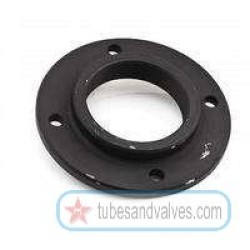Threaded Flange As Per Table E
Threaded flanges as per Table E are used in many different industrial applications. A threaded flange is similar to a slip-on flange, but the large hole in the middle is threaded. The threaded hole is provided for fastening, sealing and tying the flange to pipes, valves and other parts of an assembly. Threaded flanges are useful for connecting two pipes or one pipe to an apparatus. They are usually used in shipbuilding and in other applications where a water-tight seal is needed.Threaded flanges as per Table E are usually made from various grades of steel, brass and stainless steel. These materials are used to provide adequate strength and corrosion-resistance. Depending upon the application, threaded flanges as per Table E can be manufactured with high-pressure seal connections, butt-weld connections, or raised face connections. The raised face connection is the most common type and accounts for a greater percentage of the production of threaded flanges.When using threaded flanges as per Table E, it is important to check all dimensions very carefully, to ensure that the flange is of standard size and shape. The flange’s dimensions will vary depending on the type and size of pipe, as well as the application. The bolts used to attach the flange to the pipe must also match in size and thread to guarantee a tight seal.Threaded flanges as per Table E are generally rated for a particular pressure, however, when connecting several pieces of pipework, the pressure rating is usually lower than the individual pieces. It is important to consult the manufacturer of the threaded flange and the manufacturer of the pipes the flanges are being connected to in order to find the correct pressure rating.For use in low-pressure applications such as air and water, lightly threaded flanges designed for light-duty applications can be used. However, for high-pressure applications, heavy-duty thread flanges should be used as these are designed to contain higher pressure and heat.When installing a threaded flange as per Table E, care should be taken to ensure that all threading and nuts have been tightened correctly to ensure a leak-proof seal. The flange must also be kept clean to ensure a secure seal.Finally, the connection must be tested carefully with a pressure gauge to ensure that there are no leaks. Once the result has been proven to be satisfactory, the flange must be sealed with a suitable sealing compound to prevent leakage.Overall, threaded flanges as per Table E offer a number of advantages. They are used in various applications where a tight, secure seal is required and are usually reliable and cost-effective. When used correctly, they create a reliable system, capable of withstanding high temperatures and pressures.MS Threaded Flange FAQ's
MS Threaded Flange FAQ's
Table E
What is an MS Threaded Flange?
An MS Threaded Flange is a type of flange that has internal threads and is used to connect pipes or valves.
What is Table E?
Table E is a standard set of specifications for
BRAND: TMI
Model: 1042
25mm or 1 inch NB MS THREADED FLANGE AS PER BS 10 TABLE E25mm or 1 inch NB MS THREADED FLANGE AS PER BS 10 TABLE EThe 25mm or 1 inch NB MS Threaded Flange as per BS 10 Table E is a high-quality flange designed for use in a variety of applications. It is made from mild steel and is threaded for..
Price INR 174.00
BRAND: TMI
Model: 1042
40mm or 1 1/2 inch NB MS THREADED FLANGE AS PER BS 10 TABLE E40mm or 1 1/2 inch NB MS THREADED FLANGE AS PER BS 10 TABLE EThe 40mm or 1 1/2 inch NB MS Threaded Flange AS PER BS 10 TABLE E is a flange made of mild steel, and is designed to be used in a variety of applications. The flange is des..
Price INR 239.00
BRAND: TMI
Model: 1042
50mm or 2 inch NB MS THREADED FLANGE AS PER BS 10 TABLE EA 50mm or 2 inch NB MS Threaded Flange as per BS 10 Table E is a type of pipe flange typically used in piping systems to connect two pipes together. It is made of metal, usually steel, and is designed to provide a secure connection between t..
Price INR 305.00
BRAND: TMI
Model: 1042
65mm or 2 1/2 inch NB MS THREADED FLANGE AS PER BS 10 TABLE E
The 65mm or 2 1/2 inch NB MS Threaded Flange AS PER BS 10 Table E is a type of flange designed for use in piping systems. It is manufactured from high quality mild steel and conforms to the British Standard 10 Table E. The flange is desi..
Price INR 351.00
BRAND: TMI
Model: 1042
80mm or 3 inch NB MS Threaded Flange as per BS 10 Table EThis 80mm or 3 inch NB MS Threaded Flange is a great choice for many industrial applications. It is designed and manufactured in accordance with BS 10 Table E, which is the British Standard for threaded flanges. This flange is made from high..
Price INR 481.00
BRAND: TMI
Model: 1042
100mm or 4 inch NB MS THREADED FLANGE AS PER BS 10 TABLE EThis 100mm or 4 inch NB MS Threaded Flange is a great choice for any project requiring a reliable flange that meets BS 10 Table E standards. This flange is made from high-quality mild steel and is designed to be durable and long-lasting. It..
Price INR 550.00
Showing 1 to 6 of 6 (1 Pages)












































